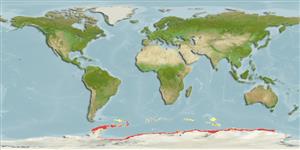Common names from other countries
Classification / Names / Names
Κοινά ονόματα | Συνώνυμα | Catalog of Fishes (gen., sp.) | ITIS | CoL | WoRMS
Environment: milieu / climate zone / depth range / distribution range
Οικολογία
βενθοπελαγικό; εύρος βάθους 0 - 1453 m (Ref. 84663). Deep-water
Southern Ocean: East and West Antarctic and South Georgia provinces.
Length at first maturity / Μέγεθος / Βάρος / Age
Maturity: Lm ? range ? - ? cm
Found in bathyal zone at depths 7-1453 m and in pelagic zone at depths 0-1000 m (Ref. 84663).
Life cycle and mating behavior
Γεννητική Ωρίμανση | Αναπαραγωγή | Γεννοβολία | Αβγά | Γονιμότητα | Προνύμφες
Members of the order Amphipoda are gonochoric and sexually dimoprhic (males larger than females). Mating behavior: Males locate potential partners with the aid of their antenna to detect the pheromones released by the females; the male then rides or carries the female until the latter is ready to molt. When the female is ready, the male pushes the sperm into the marsupium and releases the female afterwards. A few hours later, the female releases her eggs into the marsupium for fertilization. Life cycle: Eggs are brooded in the marsupium. Eggs hatch into juveniles and remain in the marsupium for a few days. Each species undergo 20 molts at most, i.e., 1-year long life cycle.
De Broyer, C., J.K. Lowry, K. Jazdzewski and H. Robert. 2007. (Ref. 84663)
IUCN Red List Status (Ref. 130435)
CITES status (Ref. 108899)
Not Evaluated
Not Evaluated
Threat to humans
Harmless
Human uses
| FishSource |
Εργαλεία
Περισσότερες πληροφορίες
Κοινά ονόματαΣυνώνυμαΘηρευτέςΑναπαραγωγήΓεννητική ΩρίμανσηΓεννοβολίαΓονιμότηταΑβγάEgg development
Age/Size
Αύξηση
Length-weight
Length-length
Μορφολογία
Προνύμφες
Αφθονία
Διαδικτυακές πηγές
Estimates based on models
Preferred temperature
(Ref.
115969): -1.5 - 1.4, mean -0.2 (based on 155 cells).
